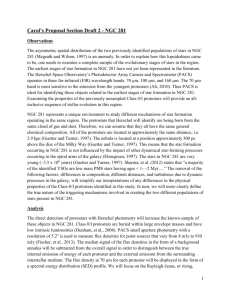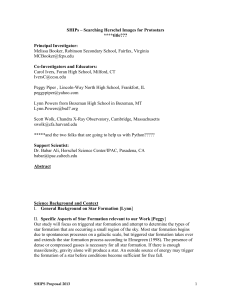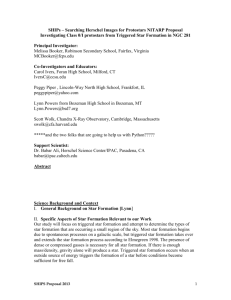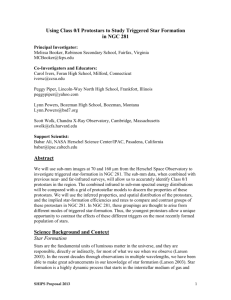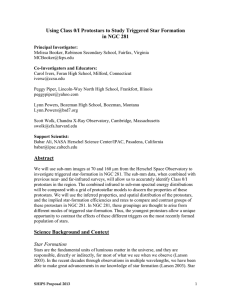SHIPS_Proposal_v03_06b
advertisement
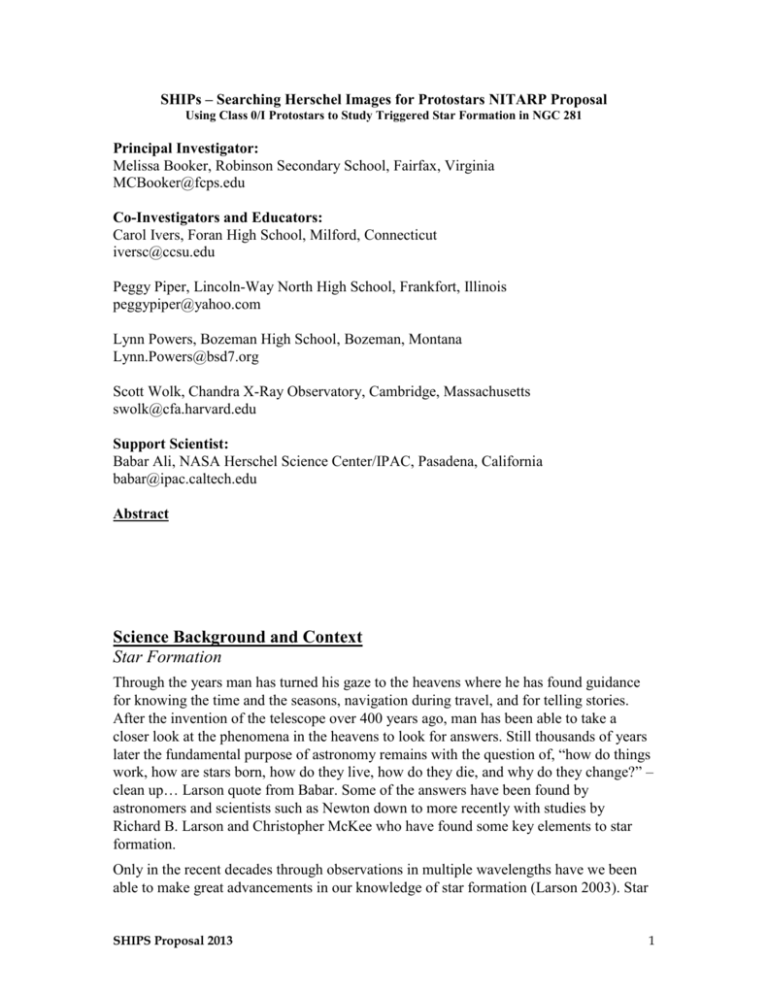
SHIPs – Searching Herschel Images for Protostars NITARP Proposal Using Class 0/I Protostars to Study Triggered Star Formation in NGC 281 Principal Investigator: Melissa Booker, Robinson Secondary School, Fairfax, Virginia MCBooker@fcps.edu Co-Investigators and Educators: Carol Ivers, Foran High School, Milford, Connecticut iversc@ccsu.edu Peggy Piper, Lincoln-Way North High School, Frankfort, Illinois peggypiper@yahoo.com Lynn Powers, Bozeman High School, Bozeman, Montana Lynn.Powers@bsd7.org Scott Wolk, Chandra X-Ray Observatory, Cambridge, Massachusetts swolk@cfa.harvard.edu Support Scientist: Babar Ali, NASA Herschel Science Center/IPAC, Pasadena, California babar@ipac.caltech.edu Abstract Science Background and Context Star Formation Through the years man has turned his gaze to the heavens where he has found guidance for knowing the time and the seasons, navigation during travel, and for telling stories. After the invention of the telescope over 400 years ago, man has been able to take a closer look at the phenomena in the heavens to look for answers. Still thousands of years later the fundamental purpose of astronomy remains with the question of, “how do things work, how are stars born, how do they live, how do they die, and why do they change?” – clean up… Larson quote from Babar. Some of the answers have been found by astronomers and scientists such as Newton down to more recently with studies by Richard B. Larson and Christopher McKee who have found some key elements to star formation. Only in the recent decades through observations in multiple wavelengths have we been able to make great advancements in our knowledge of star formation (Larson 2003). Star SHIPS Proposal 2013 1 formation is a highly dynamic process that starts in the interstellar medium of gas and molecular dense dust clouds which are typically found in the spiral bands of a galaxy (McKee & Ostriker 2007). Forces within these turbulent clouds start the gravitational condensing at the core (Larson 2003; McKee & Ostriker 2007). Gravitation at supersonic speeds collapses within the clumps of cold gas. Angular momentum turns the clump into a rotating disk. Typically a bipolar jet announces the start of a new star possibly from the interaction of the magnetic fields (Larson 2003). Accretion continues as the new star continues to grow within the infalling envelope (Larson 2003). This process takes less than 1 million years. During this time the protostar remains obscured by the gas and dust. Astronomers do not know what changes happen inside these dense clouds, or what forces are at play. A glimpse in to the star forming area is only visible at infrared wavelengths. A classification for the development of stars will help us review the stages of star formation. Class 0 – Dominant Emission – submillimeter: Early phase of rapid accretion lasting about 10,000 years. Very cold black body, most of the emissions come from the dust and gas in the cloud, the young protostars acquire most of their mass during this phase. Figure . Lynn, please provide a brief caption. Babar, please help with credit. Class I – Dominant Emission – Far Infrared: Main accretion phase lasting 105 years. Now there is a warmer black body corresponding to the central object. The dip in the spectral energy diagram (SED) at about 10 μm tells us that there are silicates in the dust. Class II – Dominant Emission – Near Infrared: Classic T Tauri star with significant circumstellar dust, lasting up to 106 years. Most of the energy is coming from the central object (warm black body), but there is still emissions from the disk. Class III – Dominant Emission – Visible: Pre-main sequence, weak line T-Tauri star that no longer has any significant circumstellar material. Specific Aspects of Star Formation Relevant to our Work Our study will focus on triggered star formation and attempt to determine the types of star formation that are occurring a small region of the sky. Most star formation begins due to spontaneous processes on a galactic scale, but triggered star formation takes over and extends the star formation process. When an outside source of energy triggers the formation of a star before conditions become sufficient for free fall the triggering process will leave sequentially younger stars in its path while clouds broken into filaments by magnetic fields will show a filamentary pattern of protostars. SHIPS Proposal 2013 2 Figure ? Schematic from Elmegreen (1998) showing clumps being squeezed to produce protostars Elmegreen (2008) describes three morphologies produced during the process of pressure induced triggering. Individual high pressure clumps or protostars A high pressure clump or protostar with a cometary or elephant trunk tail trailing away from the pressure source. Bright rims of increased density and star formation along the pressure front One way of eliminating some of the many variables affecting distribution of protostars is to focus on small regions where the formation conditions except for the trigger are the same. The processes by which protostars were created in these regions can then be considered where the physical and/or age distribution vary and multiple processes identified if they exist. Evans et al. 2009 developed a series of diagnostics to classify and study the distribution of young stars in five nearby molecular clouds in their study “from molecular cores to planet forming disks” (abbreviated c2d) using primarily Spitzer data. The slope of SEDs, bolometric temperature, and color-color diagrams were used to determine class. Criteria for this study only allowed for protostars that were detected in all Spitzer IRAC bands (3.6 – 8.0 micron) and Spitzer MIPS 20 micron and showing an infrared excess resulting in young stars through Class II. In our proposed study, we will use Herschel data to see the dust of the youngest stars allowing us to better identify Class 0 and Class I stars. Star Formation Rate (SFR), a measure of mass per unit time, was then used in the c2d study along with class determination to calculate an estimation of how much time stars spent in each of these classes. Further calculations of Star Formation Efficiencies (SFE), a ratio of the mass of the protostars to the total mass of the cloud, and star depletion time (tdep) were also made. We will use these same or similar methods in our proposed study on a region that has even tighter “controlled environment” allowing us to compare SFR, SFE, tdep, physical and age distribution of different clumps within the same star forming region but with the advantage of being able to “see” the youngest protostars using Herschel SHIPS Proposal 2013 3 Our Target: NGC 281 Figure The location of NGC 281. Credit: http://www.optcorp.com/edu/articleDetailEDU. aspx?aid=2100 Figure . NGC 281 as seen in X-ray and infrared. Credit: X-ray: NASA/CXC/CfA/S.Wolk; IR: NASA/JPL/CfA/S. Wolk NGC 281 provides an excellent laboratory for studying triggered star formation. NGC 281 is an active star-forming nebulosity about 2.81± 0.24 kpc or 9200 light-years away (Sato et al. 2008) at a relatively high galactic latitude (2000=00h52m, 2000=+5634or l=123.1, b= -6.3) in the constellation Cassiopeia (See figure ). NGC 281 contains several distinct regions (See figure ): An HII emission region Sharpless 184 of diameter 20 arcminutes containing the young galactic cluster IC 1590 centered about the OB star trapezium system HD5005 (Guetter & Turner 1997). Two quite distinct CO molecular clouds (Elmegreen & Lada 1978): o The southeastern CO region (N281A) with local standard of rest (LSR) similar to that of the HII region itself (-30.5 kms-1 vs. -26.5 kms-1) (Leisawitz 1988). This region contains highly recognizable “pillars of creation.” These pillars are known to contain newborn stars as a result of triggering from the nearby OB star trapezium system. o NGC 281 West (N281B), a molecular cloud in the southwestern region with three distinct clumps (NE, NW, and S) (Megeath & Wilson 1997). The region is heavily obscured by dust (Guetter & Turner 1997) and has a LSR (+44 kms-1) quite different from that of its eastern neighbor and the HII region it borders (Leisawitz 1988) Stars in IC 1590 The very young, galactic cluster IC 1590 has 63 identified probable members with 22 of the 63 stars are identified as pre-main sequence (Guetter & Turner 1997). Its central trapezium system, HD 5005 has four fairly hot, young main sequence OB stars (Guetter & Turner 1997). SHIPS Proposal 2013 4 Color-magnitude diagrams of IC 1590 indicate main sequence stars of spectral types O6.5 to B9.5 and pre-main sequence stars of spectral types A8/9 to G8 (Guetter & Turner 1997). The OB stars formed at the edge of a molecular cloud front are known to drive UV ionization and shock fronts further through the molecular cloud (Elmegreen & Lada 1977). Thus, it is believed that the trapezium may very well be triggering star formation in the molecular clouds in NGC 281 West (Megeath & Wilson 1997). The NGC 281 region should provide “…an excellent laboratory for studying in detail star formation through the interaction of high mass stars with their surrounding cloud” (Sharma et al. 2012) and studying “…the propagation of an ionization front into a clumpy molecular cloud and its effect on star formation” (Megeath & Wilson 1997). Because the pre-main sequence stars detected in IC 1590 have very little variability, Guetter & Turner (1997) suggest that a survey of the nearby class 0, I, II and III embedded protostars should reveal “cluster members of that type.” Indeed, Guetter & Turner further suggest that “…much information related to the star formation process could be obtained by imaging the field to fainter magnitude limits.” At the time of Guetter & Turner’s paper, far-infrared imaging was not practical. The far-infrared (FIR) wavelength bands of the Hershel Space Observatory at 70 m, and 160 m are ideal for detecting the class 0 and I stars as suggested by Guetter & Turner. Figure. Velocity integrated intensity line maps. The C18O (1-0) and C18O (2-1) maps show molecular gas is concentrated in three clumps which Megeath & Wilson (1997) denote NE, NW, and S. Credit: Megeath & Wilson 1997 SHIPS Proposal 2013 Figure . The deep K’ band image of the northern subcluster with the velocity integrated C18O (2-1) contour map overlayed. Notice how the stars are concentrated in the northern halves of the two clumps. Credit: Megeath & Wilson 1997 5 Evidence for Triggered Star Formation in NGC 281 The Megeath & Wilson (1997) radio and near-infrared studies of the 3 clumps (see figure ) in the molecular cloud of NGC 281 West near the HII/molecular cloud interface provide a deduction of the kinematic behavior in the clumps in the molecular cloud. These studies indicated that the kinetic and gravitational energy of the clumps appear to be approximately equal indicating that the clumps are not strongly gravitationally bound. This indicates that some other mechanism is confining the clumps. Megeath & Wilson (1997) suggest that the confinement of the clumps may be provided by external pressure (possibly from photoionized gas at the clump surface) or shock compression. VLA 20 cm imaging by Megeath & Wilson (1997) of the clumps in NGC 281 West indicates emission from ionized gases at the northern edge of each of the three clumps. This supports the proposal that all three clumps are exposed to the UV radiation from the O-type stars in the HD5005 trapezium. The morphology and complex kinematics of the observed C34S (32) emission in the NW and NE clumps are suggestive of radiation driven implosions (RDIs). Indeed, the velocity structures in the clumps can be explained and are consistent with models of RDIs. (Megeath & Wilson 1997). K band imaging of the northern and southern clumps in NGC 281 West shows an asymmetry in the distribution of the low mass stars in these clumps. There is a large concentration of stars near the northern edge of the NE and NW clumps and very few stars on the southern edges of the clumps. Megeath & Wilson suggest that since the stars in the NW and NE clumps are concentrated on the edges of the clumps facing the OB group (see figure ), it is “…likely that the asymmetrical distribution of stars is the results of photoionization of the clumps.” Evidence of ongoing shocks in the clumps suggest that shock triggered star formation is the best explanation for asymmetry in star distribution in the clumps (Megeath & Wilson 1997). Here again we suggest that the FIR wavelength bands of the Hershel are ideal for detecting the class 0/I protostars in the NE and NW clumps of NGC 281 West. How will we observe our target and what specific properties of NGC 281 will we analyze? The asymmetric spatial distribution of the two previously identified populations of stars in NGC 281 (Megeath & Wilson 1997) is an anomaly. In order to explain how this lopsidedness came to be, one needs to examine a complete sample of the evolutionary stages of stars in the region. The earliest stages of star formation in NGC 281 have not yet been represented in the literature. The Herschel Space Observatory’s Photodetector Array Camera and Spectrometer (PACS) operates in three far-infrared (FIR) wavelength bands: 70 µm, 100 µm, and 160 µm. The 70 µm band is most sensitive to the emission from the youngest protostars (Ali 2010). Thus PACS is ideal for identifying those objects related to the earliest stages of star formation in NGC 281. Examining the properties of the previously unsampled Class 0/I protostars will provide direct evidence of stellar evolution in this region. SHIPS Proposal 2013 6 NGC 281 represents a unique environment to study different mechanisms of star formation operating in the same region. The protostars that Herschel will identify are being born from a small region containing gas and dust with similar properties. All of the protostars are located at approximately the same distance, i.e. 2.9 kpc (Guetter & Turner 1997). The nebula is located at a position approximately 300 pc above the disc of the Milky Way (Guetter & Turner 1997). This means that the star formation occurring in NGC 281 is not influenced by the impact of other dynamical star-forming processes occurring in the spiral arms of the galaxy (Elmegreen, 1997). The stars in NGC 281 are very young (~3.5 x 106 years) (Guetter and Turner, 1997). Sharma, et al. (2012) states that “a majority of the identified YSOs are low mass PMS stars having ages < 1- ~2 Myr…” The removal of the following factors: differences in composition, different distances, and turbulence due to dynamic processes in the galaxy, will simplify our interpretations of any differences in the physical properties of the Class 0/I protostars identified in this study. In turn, we will more clearly define the true nature of the triggering mechanisms involved in creating the two different populations of stars present in NGC 281. The direct detection of protostars with Herschel photometry will increase the known sample of these objects in NGC 281. Class 0/I protostars are buried within large envelope masses and have low intrinsic luminosities (Dunham, et al. 2008). We expect to detect sources to an estimated flux limit of approximately 50mJy with PACS small aperture photometry at a resolution of 5.2″. The median signal of the flux densities in the form of a background annulus will be subtracted from the overall signal in order to distinguish between the true internal emission of energy of each protostar and the external emission from the surrounding interstellar medium. The flux density at 70 µm for each protostar will be displayed in the form of a spectral energy distribution (SED) profile. We will focus on the Rayleigh-Jeans, or rising, portion of each SED as this is where the emission from Class 0 protostars peaks while Class I protostars display SEDs that flatten after the peak (Rebull 2012). SED profiles and the derived internal luminosities will be used to constrain the envelope mass, and thus the classification, of each protostar. A previously defined grid of radiative transfer models, generated with the Monte Carlo code of Whitney, et al. (2003), was constructed by Fischer, et al. (2013). This grid is built on the physical characteristics of protostars, i.e. envelope densities, cavity opening angles, overall inclinations, and internal luminosities. This same approach will be used in this study to constrain the physical properties and varied geometry of the newly identified Class 0/I objects in our sample. (See figure below.) Similarities and differences in SED models of embedded Class 0/I protostars in NGC 281 will allow us to discern any physical differences between the two populations of protostars that exist in the region. SHIPS Proposal 2013 7 Figure ?. Model SED with peak at 70 µm and protostar geometry Credit: Ali, B., 2013, <http://coolwiki.ipac.caltech.edu/index.php/StarFormation> Analysis Plan We will use archival 70 and 160 m PACS data from the Herschel Space Observatory. One of us (BA) has expertise in the Herschel image processing and will be responsible for creating fully calibrated final mosaics of the NGC 281 region using the Herschel Interactive Analysis Environment (HIPE; Ott et al. 2010). [Please add a 1-2 sentence answer to the following questions] Lynn: How will we identify and measure the fluxes of the protostars? Color Magnitude Diagrams will be used to eliminate red but faint background galaxies from our list of protostar candidates. In addition to the FIR data from the Herschel Space Observatory, we will use data from Spitzer, WISE and 2MASS to complete our candidate class 0/I protostars SEDs. Dunham, et al. (2008) state that the value for the internal luminosity of an embedded protostar is not “a directly observable quantity,” but that it is “tightly correlated with the 70 µm flux”. Bolometric luminosity (Lbol) “is calculated by integrating over the full SED” (Dunham, et al. (2008). Bolometric temperature (Tbol) is defined as “the temperature of a blackbody with the same flux-weighted mean frequency as the source (Meyers and Ladd, 1993). Similar to the approach of Evans, et al. (2008), we will use bolometric luminosity-temperature (BLT) diagrams to constrain the evolutionary stages of the embedded Class 0/I protostars in NGC 281. (See figure below.) SHIPS Proposal 2013 8 Figure ?. Locations of embedded protostars along with plots of evolutionary models of star formation. Credit: Young & Evans 2005 Dunham, et al. (2008) state that the data for embedded protostars in previous studies does not agree well with evolutionary models based on mass accretion rates. BLT diagrams for protostars in NGC 281 will add further evidence to test the validity of these models. Education and Outreach The SHIPs team is made up of astronomers, engineers, high school educators, informal educators and high school students. While the adult educator’s first task is to immerse themselves in the research process, the next step is to share this experience with students, other educators, and the public. Our group will: begin by delving into the basics of multi-wavelength astronomy (in particular infrared and Herschel wavelengths) and the life cycle of stars (in particular star birthing regions and protostars) continue by learning aspects of image analysis and photometry challenge ourselves to learn Python programming basics for data manipulation and to generate plots utilize weekly telecons, email, and coolwiki to maintain communications Over the next year this journey will be very intense for the educators and students directly involved in SHIP s research, especially during our summer visit to Caltech and our final presentation at the AAS January 2014. Subsequently, we will pursue a variety of avenues to pay forward this experience in our schools and our communities. SHIPS Proposal 2013 9 Team Foran High School (C. Ivers): Both high school and college students from different towns in CT will participate in the NITARP-based SHIPS research project as an extra-curricular-independent study. The students involved will be required to investigate all concepts and diagnostic tools used to gain an understanding of the formation, birth, and evolution of stars. These topics will be discussed at weekly meetings and will mirror the learning taking place for teachers during weekly teleconferences. Students will be required to teach a portion of what they have already learned at each session. Data processing and analysis is a major portion of the student contribution to the project, so all students involved will learn to use the programming language Python. Educational outreach will involve teacher and student presentations within the local school district for other educators and students as well as for other area astronomy groups and colleges. Team Lincoln Way High School (P. Piper): Teachers and students from several of the districts four schools (including the districts ROTC program) will be involved in this process through the district’s new “distance learning” equipment. Student interest and commitment will be assessed through weekly sessions in which students will learn basic concepts and computer skills. Python Programming which is already being into Physics classes will be expanded and shared with other colleague. Outreach will be coordinated with Educational Outreach colleagues at Yerkes Observatory and will include sessions at local, national and international workshops. Past presentations have included local school groups, Yerkes workshops, Illinois Science Teachers Association, Global Hands on Universe and Space Exploration Educators Conference. Team Robinson Secondary (M. Booker): Six high school sophomores and juniors from Robinson Secondary will be offered the opportunity to participate in the NITARP-based SHIPs research project as an extra-curricular independent study. The students involved will be required to investigate all concepts and diagnostic tools used to gain an understanding of the formation, birth, and evolution of stars. The student research team will meet once a week to discuss astronomy concepts related to the study of protostars development. At the meetings students may be (1) learning new concepts through active learning experience, (2) learning to use the data analysis tools of the reach (e.g. DS9, APT, and Python programming), (3) engaging in discussions on current astronomy research, or (4) performing data analysis using the tools listed previously. Educational outreach will include a talk or workshop at one of the Fairfax County Public Schools inservices, at a Virginia Association of Science Teachers (VAST) meeting, a local NSTA meeting, and/or at our local Virginia Instructors of Physics (VIP) meeting. In addition, outreach will include a brief general talk on star formation at the local Northern Virginia Astronomy Club monthly meeting. Planned NASA Image Release NGC 281 is a striking star-forming complex and has already been featured in image releases from the Chandra Science Center, as well as on the popular Astronomy Picture of the Day site. http://chandra.harvard.edu/photo/2011/ngc281/ http://apod.nasa.gov/apod/ap081210.html SHIPS Proposal 2013 10 The Herschel images will provide a unique look at the youngest proto-stellar and the coldest dust components of NGC 281. We are already negotiating with the NASA Herschel Science Center to plan a series of Herschel only and Herschel+Spitzer and Herschel+Chandra image releases of NGC 281. References Ali, B., Tobin, J. J., Fischer, W. J., et al. 2010, A&A 518, L119 Ali, B., 2013 http://coolwiki.ipac.caltech.edu/index.php/StarFormation Dunham, M.M., Crapsi, A., Evans, N.J., et al. 2008, ApJS, 179, 1 Elmegreen, B. G., & Lada, C. J, 1977, ApJ, 214, 715 Elmegreen, B.G., & Lada, C. J. 1978, ApJ, 219, 467 Elmegreen, B.G. 1998, ASP Conf. Ser., 148 Evans, N.J., et al. 2009, ApJS, 181, 2 Fischer, W.J., Megeath, S.T., Stutz, A.M., et al. 2013, AN, 334, 1-2 Guetter, H.H., & Turner, D.G. 1997, AJ, 113, 6 Koenig, X.P., Leisawitz, D.T., Benford, D.J., et al. 2012, ApJ, 744, 2 Larson, R.B. 2003, Rept. Prog. Phys, 66, 1651 Leisawitz, D. 1988, NASA Ref. Publ. No. 1202 McKee, C.F., & Ostriker, E.C. 2007, ARA&A, 45, 1 Megeath, S.T. & Wilson, T. L. 1997, AJ, 114, 3 Meyers, P. C., & Ladd, E.F., 1993, ApJ 413, L47 Ott, S. et al. 2010, ASP Conference Series, 434, 139 Rebull, L. 2012, http://coolwiki.ipac.caltech.edu/index.php/Studying_Young_Stars Roger, R.S., & Pedlar, A. 1981, A&A, 94, 238 Sato, M., et al. 2008, PASJ, 60, 975 Sharpless, S. 1954, ApJ, 119, 334 Sharma, S., Pandey, A.K., Pandey, J.C., et al. 2012, PASJ, 64, 5 Whitney, et al. 2003, ApJ, 591, 1049 Young, C.H. & Evans, N. J. 2005, ApJ, 627, 293 SHIPS Proposal 2013 11
